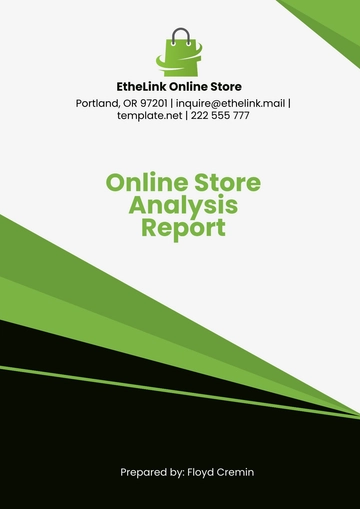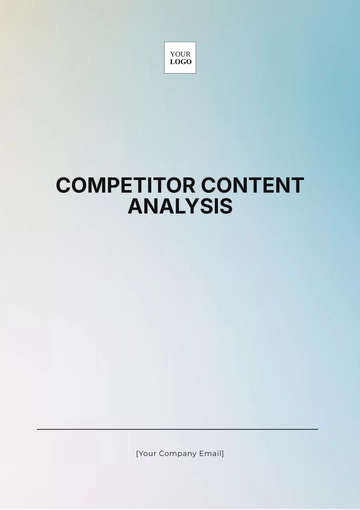Free Brand Competitor Analysis

1. Introduction to Brand Competitor Analysis
1.1 Importance of Competitor Analysis
Competitor analysis is a crucial aspect of strategic decision-making for any company. It allows [Your Company Name] to gain a deeper understanding of its competitive landscape by observing how rivals operate, what strategies they employ, and where they succeed or falter. This information is vital for several reasons:
Identifying Market Gaps: Competitor analysis helps to spot areas in the market where consumer needs are not fully met, providing opportunities for [Your Company Name] to fill those gaps with innovative solutions.
Benchmarking and Performance Evaluation: By comparing its products, services, and market strategies with those of competitors, [Your Company Name] can establish performance benchmarks to assess its own effectiveness and efficiency.
Strategic Planning and Positioning: Understanding the competitive environment helps [Your Company Name] craft a unique value proposition, ensuring its offerings stand out from the competition.
Responding to Market Trends: In today’s fast-paced markets, competitors are quick to adapt to new trends, technologies, and consumer demands. Regular competitor analysis enables [Your Company Name] to stay ahead of emerging trends and make informed decisions about product development and marketing strategies.
Given the rapidly changing nature of industries, conducting competitor analysis regularly ensures that [Your Company Name] remains competitive and adaptable to shifts in the market landscape.
1.2 Competitor Categories
The competitive environment can be divided into three primary categories, each with distinct implications for strategic planning:
Direct Competitors: These companies offer products or services similar to [Your Company Name] and target the same customer demographic. They are the immediate rivals, and understanding their strengths and weaknesses is crucial for [Your Company Name]’s positioning.
Indirect Competitors: While these companies may not offer identical products or services, they are still competitors because they vie for the same consumer spend or attention. For instance, a company offering a substitute product can be considered an indirect competitor.
Potential Competitors: These companies are not currently in the market but may enter in the future due to industry changes, technological advancements, or shifts in consumer demand. Identifying potential competitors helps [Your Company Name] stay proactive in anticipating threats.
By categorizing competitors into these three groups, [Your Company Name] can assess its competitive position in the immediate term as well as in the future.
2. Overview of Key Competitors
2.1 Competitor Identification
To gain insights into the competitive environment, we have identified the key players that pose significant competition to [Your Company Name]. These competitors have been chosen based on their market influence, innovation, and relevance in the industry. The following are the primary competitors:
Competitor A: A longstanding leader in the industry, Competitor A has a broad product range and a well-established customer base. They dominate the high-end segment with premium offerings.
Competitor B: A challenger brand that has gained traction through innovation and offering cutting-edge products at competitive prices. They target tech-savvy consumers and have a strong presence in online markets.
Competitor C: A brand known for its customer-first approach and excellent after-sales service. Competitor C excels in the mid-range segment and focuses heavily on maintaining customer loyalty.
Competitor D: A rapidly growing player in the budget segment, offering low-cost solutions without compromising on essential features. Competitor D has gained market share through aggressive pricing strategies.
Competitor E: A niche player with specialized offerings catering to a specific subset of consumers. They have a strong loyal customer base but limited product diversity.
By evaluating these competitors, [Your Company Name] can assess market share distribution and identify areas for potential growth.
2.2 Competitor Market Share
Understanding the market share distribution among competitors is crucial to evaluate where each player stands in the industry. The following table illustrates the estimated market share for each competitor in tech industry for the year 2050.
As seen in the chart, Competitor A leads the market with a dominant share, followed by Competitor B with a significant portion of the market. Competitor C occupies a respectable position in the mid-range segment, while Competitor D and Competitor E target budget-conscious consumers and niche markets.
While Competitor A holds the largest market share, Competitor B poses a strong challenge, particularly with its focus on innovation and competitive pricing strategies.
3. Product and Service Offerings
3.1 Product Portfolio Comparison
To better understand how [Your Company Name] stacks up against its competitors, a detailed comparison of the product portfolios is necessary. The table below provides an overview of the major product categories offered by both [Your Company Name] and its competitors.
Product Category | [Your Company Name] | Competitor A | Competitor B | Competitor C | Competitor D |
|---|---|---|---|---|---|
Premium Products | Yes | Yes | No | Yes | No |
Mid-range Products | Yes | Yes | Yes | Yes | Yes |
Budget Products | Yes | No | Yes | Yes | Yes |
Niche Products | Yes | No | Yes | No | No |
[Your Company Name] has a well-rounded product offering, with a mix of premium, mid-range, budget, and niche products. Competitor A primarily focuses on high-end offerings, while Competitor B targets consumers looking for affordable yet innovative products. Competitor C offers a broad range of products, but mainly in the mid-range and budget categories. Competitor D, on the other hand, is focused entirely on budget products.
This product diversity allows [Your Company Name] to appeal to various customer segments, from high-end buyers to more cost-conscious consumers. In contrast, the limited product range of competitors A and D restricts their market reach to specific customer groups.
3.2 Product Innovation and Development
Innovation is a key driver in today’s competitive market. [Your Company Name] consistently invests in research and development to create products that meet emerging consumer needs. However, it is important to understand how competitors are also positioning themselves through innovation:
Competitor A: Known for offering high-quality products, but their innovation efforts have slowed in recent years. They tend to focus more on refining existing products rather than introducing entirely new solutions.
Competitor B: An innovator in the market, Competitor B consistently releases cutting-edge products that leverage the latest technologies, such as AI, IoT, and smart features, at affordable prices.
Competitor C: Competitor C focuses more on improving the functionality and durability of its existing products, with less emphasis on groundbreaking innovations.
Competitor D: While Competitor D is highly cost-efficient, it has not invested significantly in innovation, often offering standard products with little differentiation.
In comparison, [Your Company Name] should continue its focus on high-quality, innovative products that balance both functionality and advanced technology. Additionally, investing in user experience and customer-centric features will further set it apart from competitors, especially in terms of product differentiation.
4. Brand Positioning and Market Perception
4.1 Brand Positioning Strategies
Brand positioning helps a company create a distinct identity in the marketplace. The following summarizes the positioning strategies of key competitors:
Competitor A: Positioned as a high-end, luxury brand offering the best quality in the market. The company uses traditional advertising and focuses on delivering an experience that is synonymous with exclusivity and prestige.
Competitor B: Positioned as an innovative challenger brand targeting younger, tech-savvy consumers. They focus on affordability and cutting-edge technology while maintaining high standards of quality.
Competitor C: Positioned as a reliable and practical choice, emphasizing customer service and offering affordable products with a strong value proposition.
Competitor D: Positioned as a no-frills, budget-friendly brand that caters to consumers who prioritize low prices over premium features.
For [Your Company Name], it is important to reinforce a brand message that balances quality, innovation, and affordability. Crafting a unique value proposition that resonates with multiple customer segments will strengthen its market position.
4.2 Market Perception
The perception of a brand in the market significantly impacts its ability to attract and retain customers. Competitor A enjoys a strong reputation for high-end products, but their pricing strategy can limit their appeal to a broader audience. Competitor B is seen as an innovator, while Competitor C is trusted by customers for its excellent service and dependable products.
However, Competitor D is viewed as a low-cost provider, and while this resonates with certain customers, it can limit the company’s perceived value in comparison to other players who offer a better balance of price and quality.
4.3 Customer Reviews and Feedback
Customer sentiment plays a vital role in shaping a company’s reputation. An analysis of reviews from various sources reveals:
Competitor A: Customers appreciate the superior quality of products but often cite their higher prices as a limitation. There are few complaints about the quality, but the exclusivity of the brand can create a sense of distance from certain demographics.
Competitor B: Highly praised for offering cutting-edge products at competitive prices. However, some customers report issues with product durability or after-sales service, which could harm their long-term reputation.
Competitor C: Renowned for customer service and reliability. Many customers value their strong warranties and support systems. However, there is occasional feedback about a lack of excitement or innovative features in some of their products.
Competitor D: Reviews indicate that while the pricing is favorable, some customers express dissatisfaction with the product quality and lack of advanced features.
By understanding customer feedback, [Your Company Name] can enhance product offerings and customer service strategies to meet consumer expectations more effectively.
5. Marketing and Advertising Strategies
5.1 Advertising Channels
In a fast-evolving digital age, selecting the right advertising channels is essential for ensuring that a brand reaches its target audience effectively. Each competitor utilizes a different mix of advertising strategies and channels to connect with consumers. For [Your Company Name], understanding these strategies and determining where they can carve out a unique presence is critical.
Competitor A: Primarily relies on traditional marketing channels such as television ads, high-end magazine placements, and event sponsorships. Their advertising campaigns are usually premium and geared towards an affluent consumer base. Competitor A’s digital presence is less robust, but they focus on exclusive marketing strategies that appeal to a luxury audience. Their use of celebrity endorsements and luxury lifestyle advertising reinforces their premium positioning.
Competitor B: This company has a heavy presence on digital platforms, such as social media, search engines, and video-sharing sites like YouTube. They use influencer marketing as a cornerstone of their strategy, partnering with well-known online personalities to promote products through organic content and paid ads. Additionally, they leverage online customer reviews and user-generated content, which has become increasingly powerful in shaping public opinion and driving engagement. Competitor B also frequently uses email marketing campaigns, retargeting ads, and personalized recommendations based on previous customer behaviors.
Competitor C: Focuses heavily on relationship-building rather than high-profile advertising campaigns. They use email marketing and in-store promotions to maintain customer loyalty and encourage repeat purchases. Their approach is more personal, targeting existing customers with special offers, loyalty rewards, and exclusive promotions. They also maintain a strong presence in online communities and forums where customers discuss their experiences and give feedback on products. This helps them keep a pulse on customer sentiment while directly addressing any concerns.
Competitor D: Relies on low-cost advertising strategies such as discounting, promotional offers, and placement on price comparison websites. They also employ targeted digital ads, particularly through social media platforms, but these ads often emphasize low prices and bulk-buying options. Since Competitor D is a budget brand, they have less emphasis on branding and more on delivering value to customers through aggressive pricing.
For [Your Company Name], it is important to blend both traditional and modern advertising strategies to achieve the right mix for engaging a diverse range of customers. Leveraging digital marketing with a strong focus on social media platforms, while still utilizing traditional methods for more premium offerings, will ensure a balanced approach that maximizes visibility across segments.
5.2 Pricing Strategies
Pricing is one of the most critical elements of any brand's marketing strategy. It helps shape consumer perception and influences purchasing behavior. Competitors have distinct approaches when it comes to pricing their products, which impact both their profitability and market appeal. Understanding these pricing strategies allows [Your Company Name] to evaluate its own pricing model and optimize it to meet the needs of its target audience.
Competitor A: Competitor A’s pricing strategy revolves around maintaining a premium image. They adopt a high-price, high-quality approach, where their products are positioned as exclusive and top-of-the-line. Their prices reflect the luxury and prestige associated with their brand. While this pricing strategy may limit the market segment they appeal to, it helps to establish the brand’s value proposition of superior quality. Additionally, their pricing structure is less flexible, making it difficult for price-sensitive consumers to afford their offerings.
Competitor B: Known for offering competitive pricing in the market, Competitor B uses a value-based pricing model. They provide affordable products with cutting-edge technology, appealing to consumers who are looking for high-quality products at reasonable prices. Their pricing strategy often undercuts more established players in the market, offering consumers the same level of innovation and functionality for a lower cost. This allows Competitor B to expand its customer base quickly and maintain customer loyalty through the perceived value of the products.
Competitor C: Adopts a value pricing model, where products are priced based on the perceived value they provide to customers. They focus on delivering dependable, durable products at mid-range prices, making them a solid choice for consumers who prioritize reliability over novelty or luxury. Competitor C also offers frequent promotions and discounts to further drive value perception, but they avoid price wars with other brands, focusing instead on offering consistent value over time.
Competitor D: As a budget brand, Competitor D uses an economy pricing model to attract customers who are focused on minimizing their expenses. They offer products at lower prices, often reducing the quality of materials and features to keep costs down. They position themselves as the go-to brand for price-sensitive consumers, offering basic solutions without premium features.
For [Your Company Name], finding the balance between value-based pricing and premium pricing is key. A tiered pricing model, where customers can choose between entry-level, mid-range, and premium options, would allow the brand to appeal to a wide range of customers without compromising on quality or market positioning. Additionally, introducing subscription or bundling options could attract long-term customers and improve sales.
5.3 Digital Presence
The digital landscape plays a crucial role in how companies connect with customers, create awareness, and drive sales. As digital channels continue to grow in importance, understanding how competitors are navigating this space will provide valuable insights for [Your Company Name] to build a robust online presence.
Competitor A: Although Competitor A has a more traditional marketing focus, they have slowly adapted to digital channels in recent years. They have an exclusive, sophisticated e-commerce website that mirrors their premium brand image. Competitor A is present on high-end digital spaces such as luxury online magazines, targeted social media ads, and through partnerships with celebrities and influencers. However, their overall digital presence remains secondary to their offline brand strategy.
Competitor B: Dominates digital channels, with a strong presence on social media, search engines, and e-commerce platforms. They have built a substantial online community and frequently use paid digital ads, including Facebook and Instagram ads, to promote product launches and sales events. Their digital strategy is heavily dependent on interactive content, user reviews, and influencer collaborations to engage potential customers. They also optimize their website for search engines, ensuring that they appear in search results when consumers look for affordable, innovative products.
Competitor C: While Competitor C has a more traditional marketing approach, they also leverage their digital presence effectively by using email marketing, retargeting ads, and loyalty programs. They engage customers via social media channels, focusing on user feedback and creating strong customer support platforms. Their digital presence is less about driving direct sales and more about maintaining ongoing relationships with existing customers.
Competitor D: Competitor D’s digital presence is centered around cost-effective, straightforward advertising. They rely on search engine ads, banner ads, and discount coupon websites to attract budget-conscious shoppers. They don’t heavily invest in content marketing or social media but focus on direct digital sales through promotions and price comparisons.
For [Your Company Name], establishing a robust digital presence through social media, search engine optimization (SEO), content marketing, and a user-friendly e-commerce platform is essential. By creating engaging content and interacting with consumers, [Your Company Name] can strengthen its online identity and drive customer loyalty.
6. Future Trends and Strategic Recommendations
6.1 Emerging Trends in the Market
To stay competitive in an ever-changing market, [Your Company Name] must identify and adapt to future trends that could redefine the industry. The following emerging trends are expected to influence the market post-2050:
Sustainability: Consumers are increasingly looking for brands that demonstrate environmental consciousness and sustainability in their products, services, and business operations. By 2050, sustainability will no longer be a niche concern but a core expectation across industries. Brands that fail to prioritize sustainability will risk losing market share to more eco-conscious competitors.
Automation and Artificial Intelligence: The use of AI and automation in product design, customer service, and marketing will continue to rise. Personalized experiences powered by AI, such as tailored recommendations or chatbots for customer support, will help brands cater to individual needs more effectively. Automation will also streamline supply chains and operations, reducing costs and improving efficiency.
Augmented Reality (AR) and Virtual Reality (VR): As technology evolves, the use of AR and VR in retail and marketing will become more commonplace. These technologies will allow consumers to interact with products in virtual spaces before purchasing them. For example, VR can enable customers to "try on" clothing virtually, while AR can be used for in-store navigation or interactive product demos.
Subscription Models: As customer behavior shifts toward more flexible, predictable consumption patterns, subscription-based models will gain traction. Subscription services, particularly in industries such as entertainment, food, and wellness, will allow businesses to generate a steady stream of revenue while fostering long-term customer relationships.
5G Connectivity: With the rollout of 5G networks, internet speeds will increase exponentially, opening up new opportunities for businesses to engage with consumers through more immersive experiences, faster transaction processing, and improved live streaming capabilities.
6.2 Strategic Recommendations for [Your Company Name]
To leverage emerging trends and remain competitive in the future, [Your Company Name] should consider implementing the following strategies:
Sustainability Focus: Develop products with environmentally friendly materials and sustainable production processes. Position sustainability as a core part of the brand’s mission and communicate this commitment through all channels, from product packaging to marketing materials.
AI and Automation Integration: Invest in AI technologies for personalized customer experiences, such as recommendation systems and tailored content. Automation can be applied to logistics, inventory management, and customer support, reducing costs and improving efficiency.
Leverage AR and VR Technologies: Incorporate AR and VR into the shopping experience, allowing customers to visualize products in real time or simulate experiences before making a purchase. This can be particularly impactful in industries like fashion, home decor, and automotive.
Subscription and Bundling Options: Consider offering subscription models where customers can receive regular product shipments or gain access to exclusive content. Bundling products together at discounted rates can also help increase customer loyalty and lifetime value.
5G Adaptation: Prepare for the future by optimizing your digital infrastructure to handle the speed and capabilities of 5G. Use this to enhance customer interactions, improve data-driven marketing strategies, and create new opportunities for immersive, real-time customer engagement.
7. Conclusion
Conducting a comprehensive brand competitor analysis is essential for [Your Company Name] to maintain its competitive edge and navigate the challenges of a rapidly evolving market. By understanding the strategies of its competitors, identifying emerging trends, and implementing forward-thinking strategies, [Your Company Name] can position itself for success in the decades to come. Regular competitor analysis will provide invaluable insights that allow the company to remain adaptable, innovative, and ready to capture opportunities in the competitive landscape.
As [Your Company Name] continues to focus on product innovation, customer engagement, and sustainability, it will be well-prepared to thrive in the changing marketplace. By staying ahead of market shifts, leveraging digital channels, and embracing emerging technologies, [Your Company Name] can secure its position as a leader in its industry well into the future.
- 100% Customizable, free editor
- Access 1 Million+ Templates, photo’s & graphics
- Download or share as a template
- Click and replace photos, graphics, text, backgrounds
- Resize, crop, AI write & more
- Access advanced editor
Gain a competitive edge with the Brand Competitor Analysis Template from Template.net. This editable and customizable template simplifies analyzing competitors’ strengths, weaknesses, and market positioning. Easily personalize it with the AI Editor Tool to create actionable strategies. Stay ahead of the competition and enhance your brand growth today!





























